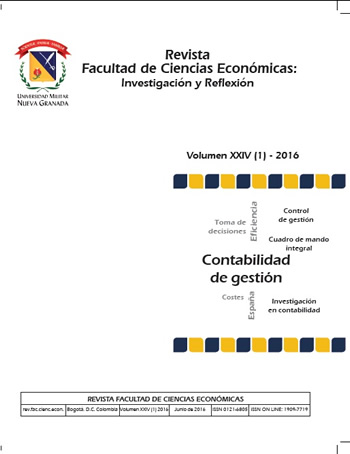Impacto del revenue management en los sistemas de control de gestión
Resumen
El Revenue Management (RM) tiene por objeto prever la demanda de productos o servicios de la manera más precisa posible, a fin de poder establecer y adaptar las decisiones de precio y disponibilidad de productos, en los diferentes canales de venta, y maximizar la rentabilidad. El RM trata de maximizar el ingreso que puede alcanzar una empresa con una capacidad fija de fabricación de un producto o de prestación de un servicio; así, el objetivo es tratar de destinar la capacidad a aquellos clientes que aportan más valor a la empresa, asignándoles la capacidad adecuada. En este marco de actuación se suele aludir, constantemente, a la necesidad de generar un resultado, o alcanzar una rentabilidad, sin embargo a estos efectos sólo se toman en consideración los costes variables, y en menor medida los costes fijos, lo que nos lleva a plantear la cuestión ¿qué impacto tiene el método de cálculo de costes en los procesos de gestión de ingresos? Esta es la cuestión que conforma el objetivo del presente artículo, al identificar cuáles son las interrelaciones que existen entre la contabilidad de gestión y el RM, dado que ambas perspectivas son complementarias en el logro de un objetivo común, como es buscar la mayor eficiencia y efectividad económica de las operaciones desarrolladas por cualquier empresa.Descargas
Lenguajes:
esReferencias bibliográficas
Anderson, C. K. & Wilson, J.G. (2003). Wait or buy? The strategic consumer. Pricing and profit implications. Journal of the Operational Research Society, 52 (3), 299-306
Benigno, S., Guerriero, F. & Miglionico, G. (2012). A revenue management approach to address a truck rental problem. Journal of the Operational Research Society, 63(10), 1421–1433.
Besana, A. (2012). Alternative Resources: Revenue Diversification in the Not-for-Profit USA Symphony Orchestra. The Journal of Arts Management, Law, and Society, 42, 79–89.
Boyd, E. A., & Bilegan, I. C. (2003). Revenue Management and E-Commerce. Management Science, 49(10), 1363–1386.
Boyd, E. (2007). The future of pricing: How airline ticket pricing has inspired a revolution. New York. Palgrave. MacMillan.
Buckhiester, B. (2011). Revenue Management as a Multi-Disciplinary Business Process: Part One. The Journal of Hospitality Financial Management, 19(1), 91–103.
Bujisic, M., Hutchinson, J. & Bilgihan, A. (2014). Journal of Foodservice Business The Application of Revenue Management in Beverage Operations. Journal of Foodservice Business Research, 17, 336–352.
Cheraghi, S. H., Dadashzadeh, M. & Venkitachalam, P. (2010). Revenue Management In Manufacturing: A Research Landscape. Journal of Business & Economics Research, 8(2), 63–72.
Ciancimino, A., Inzerillo, G., Lucidi, S. & Palagi, L. (1999). A Mathematical Programming Approach for the Solution of the Railway Yield Management Problem. Transportation Science, 33(2), 168–181.
Cross, R.G. (1997). Revenue management: Hard-core tactics for market domination. New York; Broadway Books.
Gallien, J. & Wein, L. M. (2005). A Smart Market for Industrial Procurement with Capacity Constraints. Management Science, 51, 76–91.
Guadix, J., Onieva, L., Muñuzuri, J. & Cortés, P. (2011). An overview of revenue management in service industries: an application to car parks. The Service Industries Journal, 31(1),
Huefner, R. J. (2011). A Guide to Integrating Revenue Management and Capacity Analysis. Management Accounting Quarterly, 13, 40–46.
Huefner, R. J. & Largay, J. a. (2008). The role of accounting information in revenue management. Business Horizons, 51, 245–255.
Karmarkar, S. & Dutta, G. (2012). Multi-period revenue management model for internet advertising. Journal of Revenue and Pricing Management, 11(2), 225–239.
Kimes, S.E. (2005). A strategic approach to yield management. In A. Ingold; U. McMahon-Beattle; I. Yoeman . Yield management strategic for the services industries. 2nd Ed. Londond. Thomson Learning, 3-14.
Kumar, S. & Frederick, J. L. (2007). Revenue management for a home construction products manufacturer. Journal of Revenue and Pricing Management, 5, 256–270.
Leask, A., Fyall, A. & Garrod, B. (2013). Managing revenue in Scottish visitor attractions. Current Issues in Tourism, 16(3), 240–265.
McGill, J. & Van Ryzin, G. (1999). Revenue Management: Research Overview and Prospects. Transportation Science, 33(2), 233–256.
Milani, J. (2012). Improving Revenues in Financial Services Through Customer Service and Revenue Management (CSRM)®. Journal of Performance Management, 24, 3–15.
Ng, I. C. L. & Yip, N. K. T. (2011). Mechanism design in an integrated approach towards revenue management: the case of Empress Cruise Lines. The Services Industries Journal, 31(3), 469–482.
Ovchinnikov, A. & Milner, J. M. (2010). Revenue management with end-of-period discounts in the presence of customer learning. Production and Operations Management, 21(June), 69–84.
Phillips, R.L. (2005). Pricing and revenue optimization. Stanford, CA; Stanford University Press.
Queenan, C. C., Ferguson, M. E. & Stratman, J. K. (2011). Revenue management performance drivers: An exploratory analysis within the hotel industry. Journal of Revenue and Pricing Management, 10(2), 172–188.
Schönberger, J. & Kopfer, H. (2012). Revenue management in road-based freight transportation: Impacts of uncertainty of capacity consumption. International Journal of Physical Distribution & Logistics Management, 42(4), 388–403.
Shields, J. (2006). Revenue management: A strategy for increasing sales and revenue in small business. Journal of Small Business Strategy. 16 (2), 43-53.
Smith, B.C., Leimkuhler, J.M. & Darrow, R.M. (1992) Yield management at American Airlines. Interfaces, 22 (1), 8-31.
Swan, J. H., Hunter, H. R. & Tumelty, R. (1997). Medicare Revenue in Large Medical Groups. Journal of Healthe & Social Policy, 9(1), 23–44.
Talluri, K. & van Ryzin, G. (2004). Revenue Management Under a General Discrete Choice Model of Consumer Behavior. Management Science, 50, 15–33.
Ting, S.-C. & Tzeng, G.-H. (2004). An optimal containership slot allocation for liner shipping revenue management. Maritime Policy & Management, 31(July-September), 199–211.
Vercio, A., Bayliss, A. & Thompson, L. L. (2005). Fourteen types of idle capacity. Cost Management, July - Aug, 35–39.
Wang, X. L. & Bowie, D. (2009). Revenue management: the impact on business-to-business relationships. Journal of Services Marketing, 23(January), 31–41.
Wirtz, J., Kimes, S.E., Pheng Theng, J.H. & Patterson, P. (2003) Revenue management - Involving potential customer conflicts. Journal of Revenue & Pricing Management, 2 (3), 216-226.
Withiam, G. (2001). The 4 C strategy for yield management. Center for Hospitality Research Report. Ithaca, NY; Cornell University.
Zhang, M. & Bell, P. (2012). Price fencing in the practice of revenue management: An overview and taxonomy. Journal of Revenue and Pricing Management, 11(2), 146–159.
Zurheide, S. & Fischer, K. (2012). A revenue management slot allocation model for liner shipping networks. Maritime Economics & Logistics, 14(3), 334–361.












